Dear Reader, in this age of AI created content, please support with your goodwill someone who works harder to provide the human-made. Sign up at the top of the lefthand column or bottom of this page. You will receive my hand illustrated monthly newsletter RESTORE NATURE and access to the biodiversity garden design course as I write...and nothing else, I respect your time. I am also removing the advertizing as best I can as its become intrusive inappropriate and pays me nothing.
Introduction
to a free course on designing and building your own
food jungle.
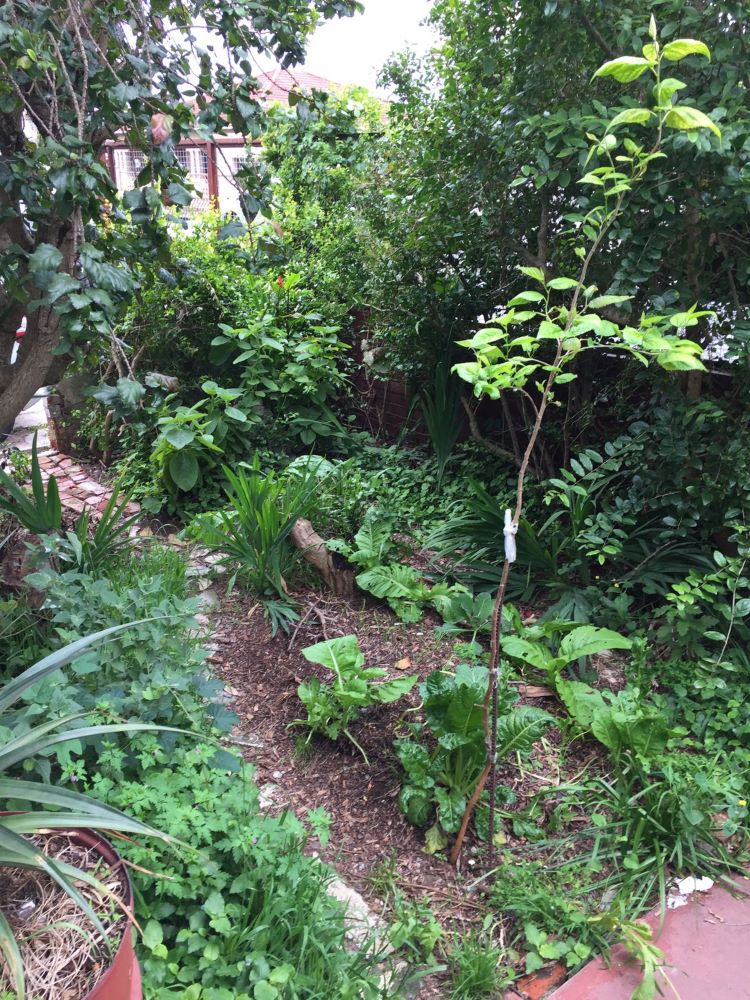 A well worn path to the wider roads of the world. Only the passing of many feet creates a semblance of order, because the system is always on the brink of chaos.
A well worn path to the wider roads of the world. Only the passing of many feet creates a semblance of order, because the system is always on the brink of chaos.Access to food jungle course via newsletter subscription
Do you want to live in a food jungle ? This is the first stage in a free course on designing and building food jungles. It will be delivered via my monthly newsletter. Each newsletter will give a link to a section of the course that will give a broad explanatory outline of a particular topic and contain links to relevant material and resources for that topic. Only subscribers will have access to the explanatory outlines of the course. Subscription is free. It should take about a year to complete. The reason I give this for free is that I believe in the benefit to our ecosystems and global health of making food jungles, and I don't want anyone to be unable to do the course for financial reasons.
Business and family friendly, finance friendly
free food jungle course
Taking a year is not because it is complicated or overwhelming, but because I need time to write the course material well, as I don't use writing bots, and people following the course need time to practice what they learn in the garden before engaging with the next idea. The course will not be about absorbing factual information, but about interacting with nature as represented in your garden, observing and sharing what you've seen and optimizing your practice based on what you've thought through. I would also like it to be possible for anyone to complete the course while working for a living elsewhere. I don't want anyone to be unable to do the course because of time constraints. I also don't see the state of my own knowledge as anything near complete and I also need space to grow and change as we go.
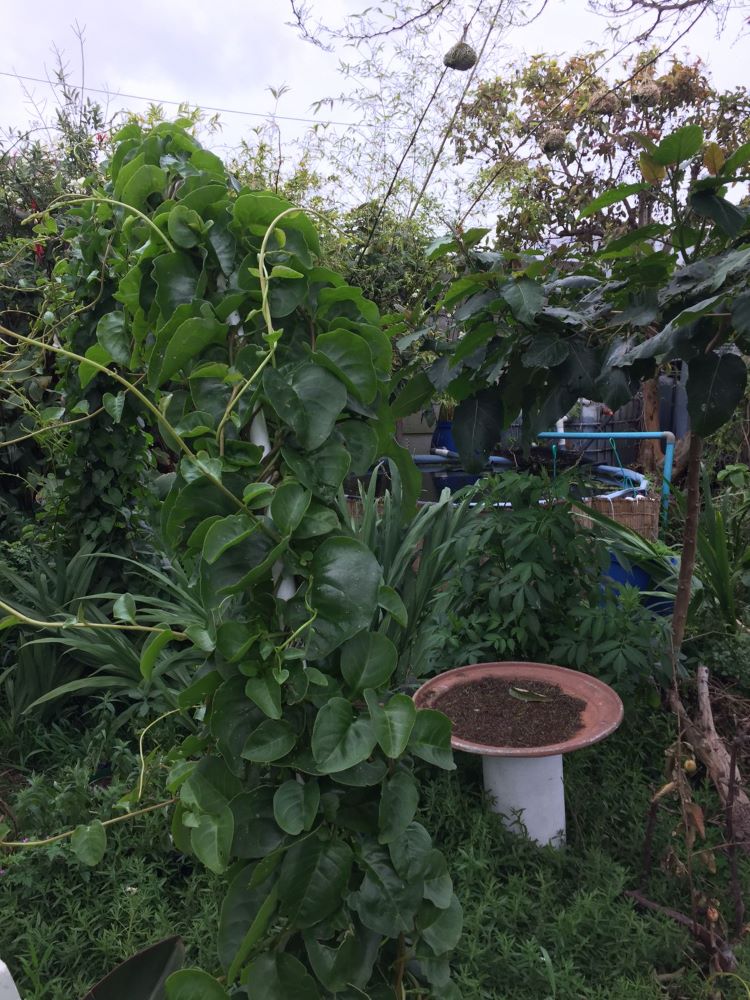 The food plants form a wilderness and the avian engineers weave wonderful nests on the edible bamboo. Each cane carries multiple nests bouncing in the wind.
The food plants form a wilderness and the avian engineers weave wonderful nests on the edible bamboo. Each cane carries multiple nests bouncing in the wind.So what is a food jungle ?
The first thing I need to do for you is introduce the idea of the food jungle, and explain the use of the term. I use the word jungle because I like to create a strong biodiversity focus when building a 'food forest'. Everyone must have their 'unique selling point' and I'm afraid I do have one, built in. I grew up in the house of a biodiversity activist. Still, it took me decades to recognize the importance of biodiversity. Now I am extremely concerned. There are so many problems in this world as we hurtle forward, from shrinking population growth to pollution, social unrest and growing inequality, and the dreaded C. By this I mean consumption, not Carbon, as I'm with the people who argue that Carbon is not the sole source of climate change, and a major driver is land degradation. This is hard to separate from biodiversity. We can't do everything, and working against degradation, via working against the mass extinction of life forms on earth is my chosen area of activism.
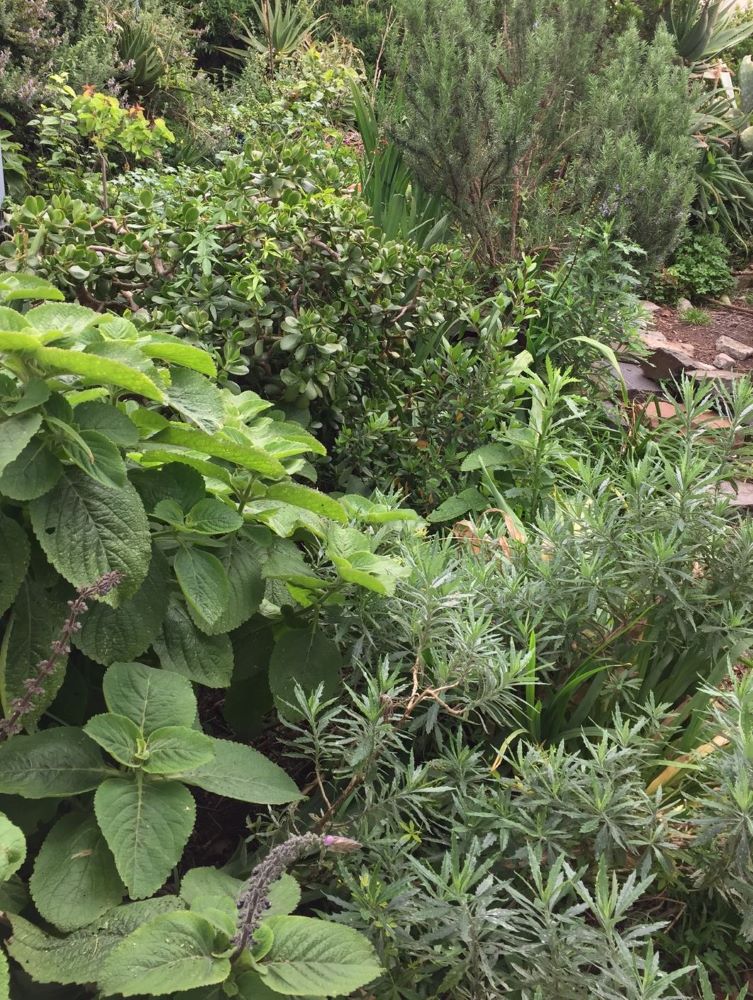 A multi tiered herby jungle just a meter high. Saplings emerge from its shadows after enjoying the shade and protection provided.
A multi tiered herby jungle just a meter high. Saplings emerge from its shadows after enjoying the shade and protection provided.Why is business as usual not enough ?
If biodiversity is high on the agenda, why not dovetail oneself in with existing nature based farming methods. Why not speak from under the umbrella of another earth friendly school of thought ? I hope to lay out the answer to this question here and persuade you of the necessity of the food jungle concept and what it will teach.
The primary reason we need to start with a new focus is that it biodiversity is being marginalized by some of the people who should be it's flagship propagators, the permaculture movement, organic farmers and agroecologists of this world. When you talk up your contribution to something while marginalizing it, the home ground of your discourse is the most dangerous place for that topic, where the greatest invisible silencing occurs. This is not necessarily intended silencing but unconscious.
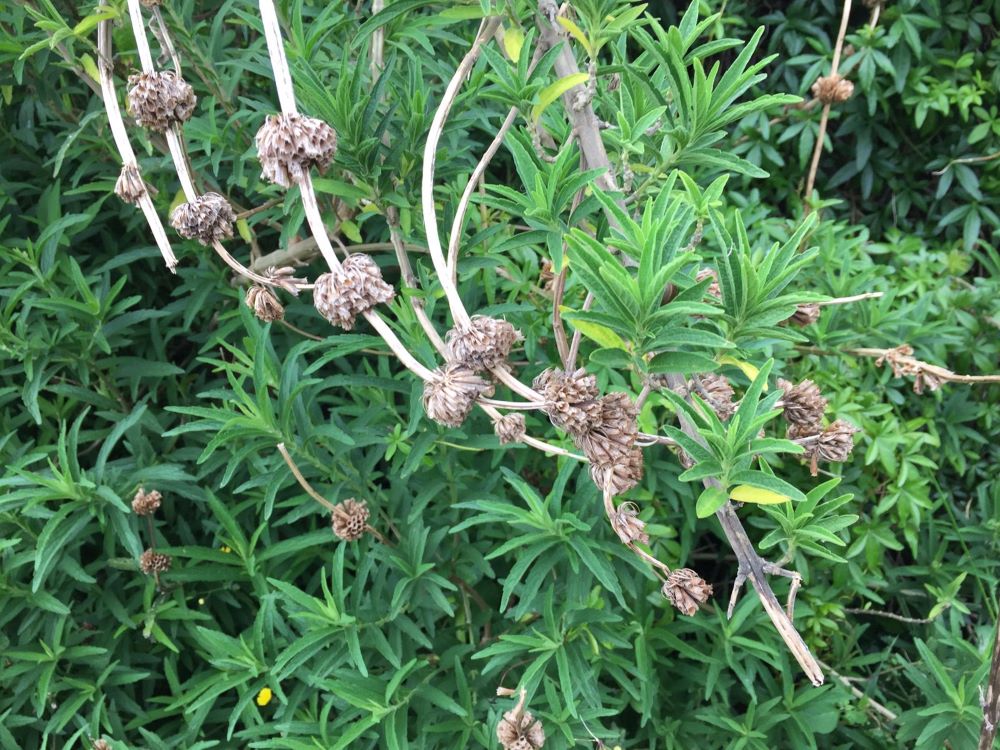 dead heading would deprive humans of the delight at these strange seed forms, and dainty ants of a source of food.
dead heading would deprive humans of the delight at these strange seed forms, and dainty ants of a source of food.Very briefly: What is a food forest ?
You've heard of a food forest, I'm sure. There are many proponents of the idea, who will differ in how they see it. In permaculture it is generally explained as a planting of carefully chosen food and support plants which are allowed to progress through succession over the years till they reach their climax form as a food providing forest. It may be mentioned that the food forest should include all the seven storeys of a forest as productive plants: the canopy, under storey, shrub layer, herb layer, groundcovers, roots and vines. The aim is to create a low maintenance, self sustaining food producing 'ecosystem'. Along the way techniques are used such as planned heavy chop and drop mulching in syntropic farming, or chop and drop mulching to clear space, promote fungal growth, fertility and water retention in the soil, as the whole system moves through succession as explained by Geoff Lawton in his videos (click here). The various schools of thought behind food forest creation often overlap. They are often very similar except for their being a different dynamic that is the intellectual focus of the teaching.
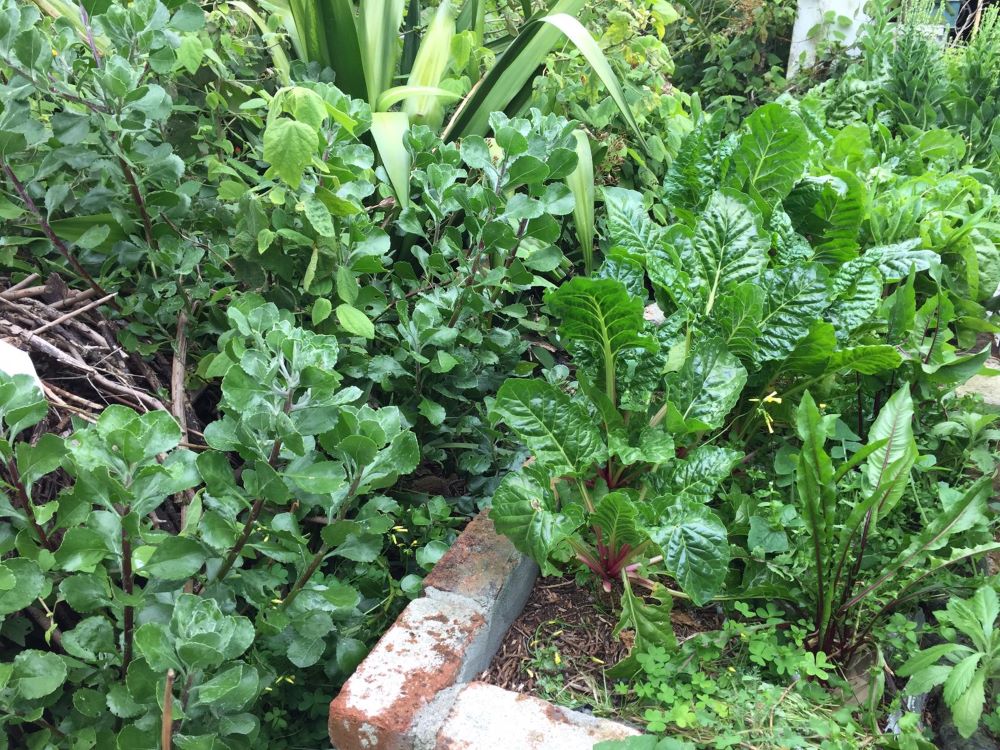 Cheek by jowl, a water fed bed for pampered chard and a wild Bietou daisy growing in the sand. The daisy supports dozens of insects.
Cheek by jowl, a water fed bed for pampered chard and a wild Bietou daisy growing in the sand. The daisy supports dozens of insects.Beautiful idea.... BUT....
It is often stated that food forests promote biodiversity. As I am so concerned with biodiversity, it would be expected that I'll embrace the food forest concept but focus on the biodiversity angle more than most. This has been true for a long time. Eventually I began to see that the whole idea was too human centered for me. It is not to exclude humans from the reckoning. They just must be situated as part of the ecosystem, not its reason for existence. The food forest idea is potentially one of the greatest blessings for the planet but when biodiversity is forgotten, it fails at a fantastic opportunity. With a biodiversity focus one would use different methods to those gardeners whose primary aim is to grow food. I also must say loudly that the mechanism for creating animal diversity in the food jungle is not just a knock on effect of forest building, being good and putting away the poisons, but uses specific strategies that I will explain further in the course.
There is another reason to strive for something different than the usual food forest. Over time, like a metaphor, a commonly used word becomes de-natured and even shifts in meaning. Thus the term food-forest and the ecological aspects of food forest creation taught by Geoff Lawton and Ernst Gotsch have become watered down as the idea spread across the world till a food forest can mean something like a 'mixed orchard' or 'alley cropping' or even just a vegetable garden with some perennials. I would not mind if this did not contain a hidden danger to biodiversity that people need to be aware of. Creating forest systems is great. Why not add a few tweaks and go the whole way. Support all life not just our own.
These days you will see many a food forest which does not do much for biodiversity. People do not do this on purpose, but because their focus is elsewhere and they have therefore missed out on just a few small things that would push the effect of what they do in the other direction, towards the regeneration of biodiversity.
Ernst Gotsch when asked to define syntropic farming said that its essence was to create an ecosystem as close as possible to that which would have occurred naturally there before. He certainly created jungles which do not look man made, but deliver crops. That intense value, akin to spiritual awe that he places in natural ecosystems is not visible in all of the creations of people claiming to be his followers. The priorities of the farmer are revealed in the farm. In sum, I've realized that if you want to integrate biodiversity and food production you need to nail it to the door and not follow anyone or any available group of people. They have all been misinterpreted to the point of their message being lost.
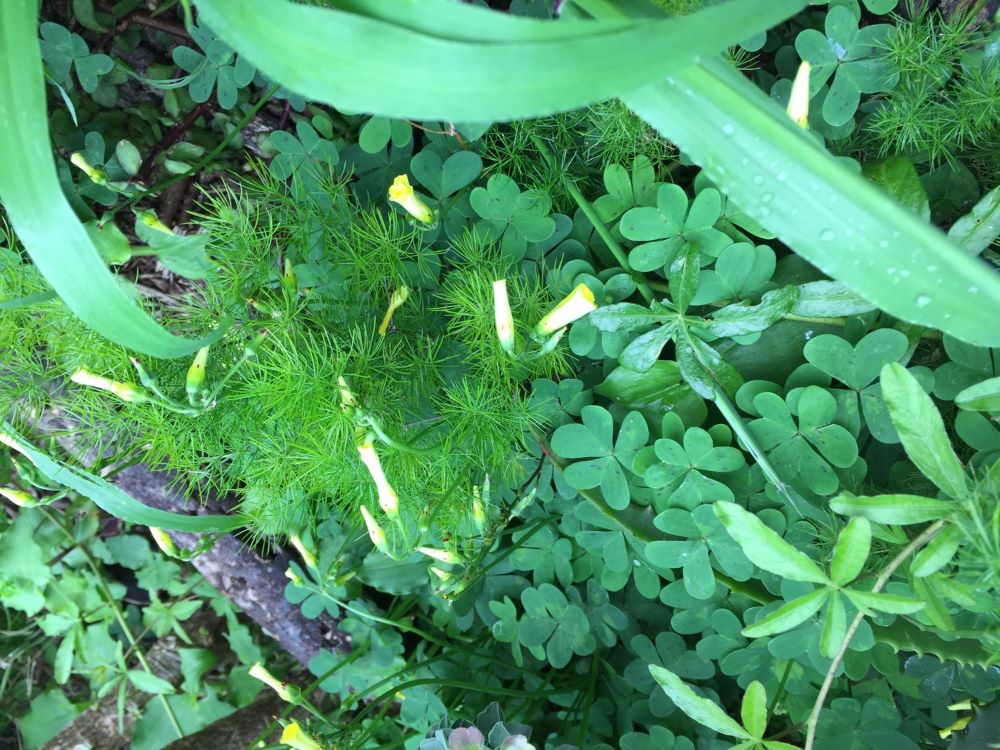 Hopefully the asparagus will form a think thorny tangle and its microscopic flowers make a million hoverflies happy. It is a long wait for those 3 meter long succulent shoots.
Hopefully the asparagus will form a think thorny tangle and its microscopic flowers make a million hoverflies happy. It is a long wait for those 3 meter long succulent shoots.So why the new language ?
The aim of creating a new term is to revitalize the importance of biodiversity in food gardening. By using a word that could create a new, more intense focus on biodiversity I am hoping that a way of growing food will develop that is a lot more effective at supporting wildlife and combating the loss of species worldwide.
A food jungle is like the idea of a food forest, but one in which the protection of biodiversity and wildlife is taken very seriously. In food jungle design it is not assumed there will be an explosion of wildlife just because one uses organic practices and puts away the roundup. Every region of the world will have to develop its own plant lists, and every micro region a palette of native food plants that is utterly unique. We need less 'how to grow' instruction from nature gardeners on the other side of the planet and more culturing of our own plants and friendships with other denizens of our local ecosystems.
What secrets are hiding in the word 'jungle' ?
At first I chose the word 'jungle' to describe a food forest with biodiversity focus because of the present meaning of 'jungle' in English. But it has a deeper history and as I explored the etymology of the term I was even more delighted with it.
Today in English we understand jungle as dense forest with tangled vegetation. Thus it includes wildness and excludes tidiness from the get go. It is well known that some unkempt areas and a bit of wildness in a garden are good for wildlife. The term jungle is often used to describe tropical forest or southern hemisphere forest, another plus, as the closer to the tropics the greater the biodiversity and it is in the tropics where biodiversity conservation thus has the most global impact.
Another sense given by the dictionary writers is that a jungle is impenetrable. In a jungle there is so much vegetation at ground level that it is hard to walk through it. This distinguishes it from rain forest which is dark under the tree canopy and has little vegetation at ground level.
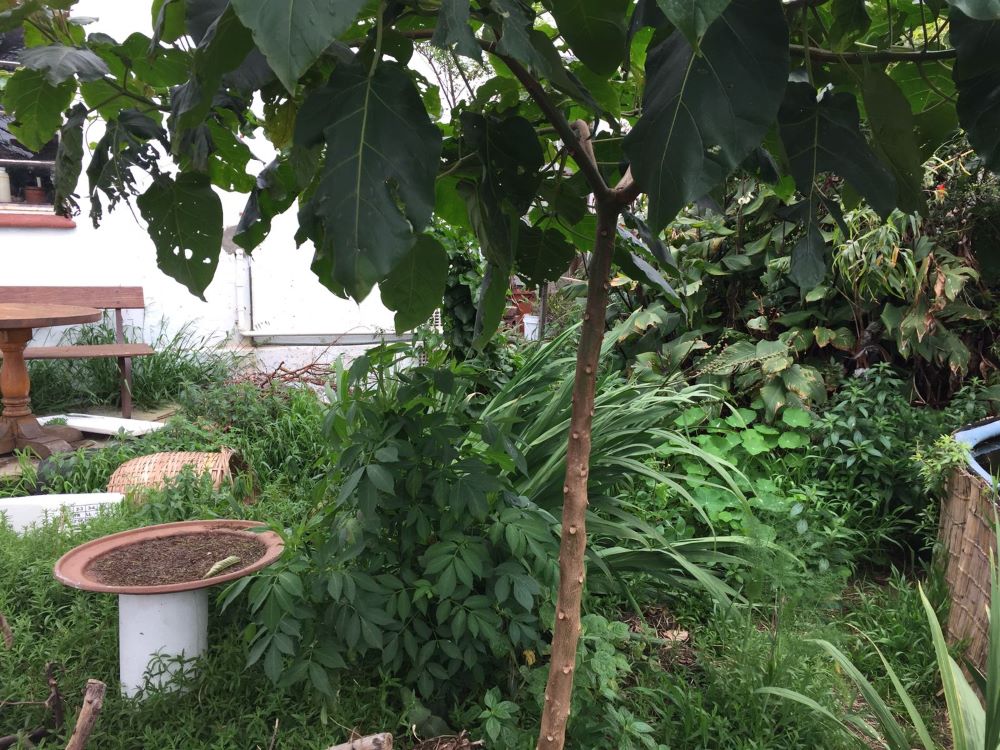 The story of storeys. Tamarillo never looked so good. Growing under the sweet thorn's shade.
The story of storeys. Tamarillo never looked so good. Growing under the sweet thorn's shade.What is the environment that is most associated with the word 'forest' ?
Thinking about European forest that I've seen and photographs of north American old growth forest, this two dimensional geometry, or pattern seen in a rain forest also seems to prevail where it is cold. These northern forests often consist of tall established trees, and very little low under growth. The tropical rainforest is similar, but it may be thinner below the canopy due to lack of sunlight, whereas the deciduous northern forests are probably thinner below the canopy because of the cold which restricts growth and the growing season. In autumn the vegetation dies back and in winter all you have is leaf covered ground and tree trunks. There is plenty of light on the forest floor but it is too cold for new growth. The green growth in summer is from woody trees and shrubs which have leafed up, and on the forest floor, the kind of vegetation which grows in a season, consisting of annual herbs, resprouting and bulbiferous plants, with some quicker growing larger plants on the margins. The speed of summer growth in the north is something which impresses a viewer used to perennially green forests. It seems almost explosive. Those northern plants do make up for lost time. The mushrooms and mosses add a lot of diversity to these cold forests and are quite glorious in old growth areas.
But yet there are a couple of layers missing, the layers which make a forest look like a jungle. The impenetrable profuse growth of a jungle is something found in warmer climates, and nature may generate a different mental model in these areas. Without the density of layers, a tropical food jungle would be impoverished. In the garden I would like to be able to take advantage of all the niches and productive possibilities a jungle provides.
We and our mental models are a product of the environment we're used to.
I believe the natural growth we are surrounded by affects our mental models. In the northern European and north American consciousness a forest consists of tall trees with low ground covers and herbs at ground level. The model based on observation influences and forms the template for man made tree systems like orchards and alley cropping. This two dimensional, vertical and flat system is a mental model so hard to shed that it has permeated the consciousness of the world, despite the teaching on the multiple tiers of the forest that is given by teachers like Geoff Lawton. In the worst case scenario of forest minimalism, the northern 'food forest' consists of trees mulched by wood chips.
The jungle found in warmer areas of the world is far away from a neat potager sensibility with its fluffy brown compost mulched beds that echo the carpet of fallen leaves. Implicit in the understanding of the word jungle is that it has total vegetation cover, vegetation crowded in time and space. No piece of earth is waiting and no plant surrounded by empty space or time. The meaning of the term 'forest' can encompass this fullness, but fullness is not necessary to its meaning.
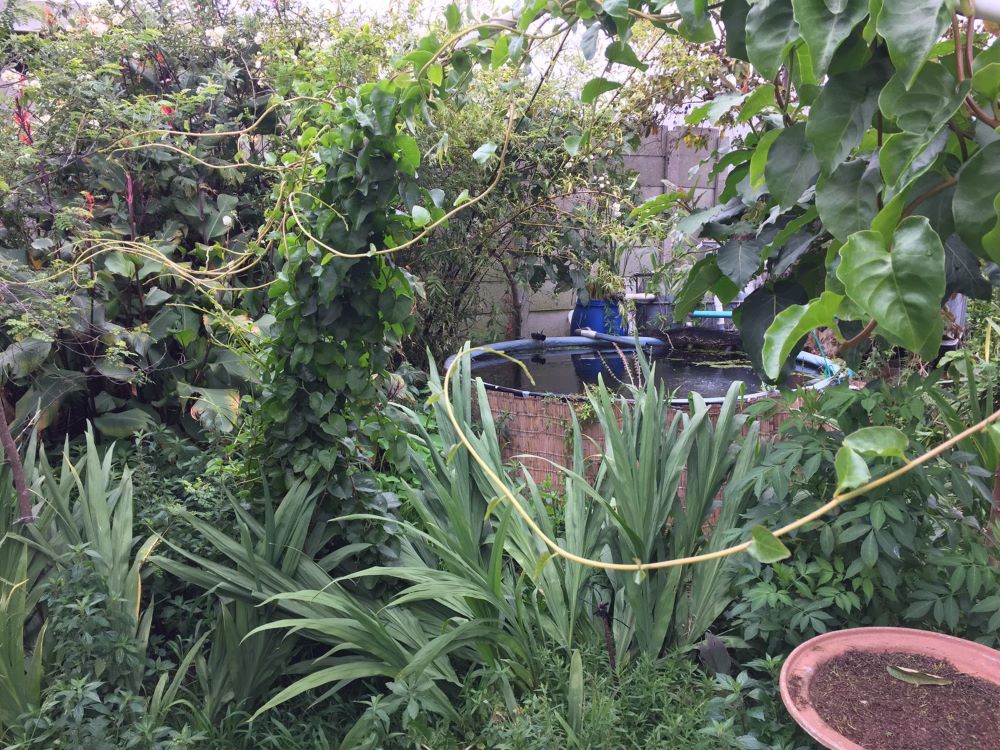 Climbing spinach tendrils, indigo tree, bamboo, tetragonia, chasmanthe explode with life.
Climbing spinach tendrils, indigo tree, bamboo, tetragonia, chasmanthe explode with life.To capture the necessity of biodiversity, the metaphor and etymology of the jungle rules.
The term food jungle is a more precise choice for a multitiered semi wild system than food forest, as fullness and wildness are necessary to the meaning of the word jungle. Biodiversity is less likely to become marginalized within such a concept.
The older meanings of the word 'jungle' are even more apt for biodiversity. The word comes from the Sanskrit jangala which surprisingly means rough and arid ! In Iran there is a cognate (similar sounding word that originated from a common root in an older language) 'jangal' which was transferred to Urdu and is used to refer to forests. What is most exciting of all is that the word 'jangala' has another meaning and is understood in many languages of the Indian subcontinent to mean
"the tangled vegetation that appears in disturbed areas, the kind of naturally occurring plant growth replacing old growth forest"
(to quote the dictionary verbatum).
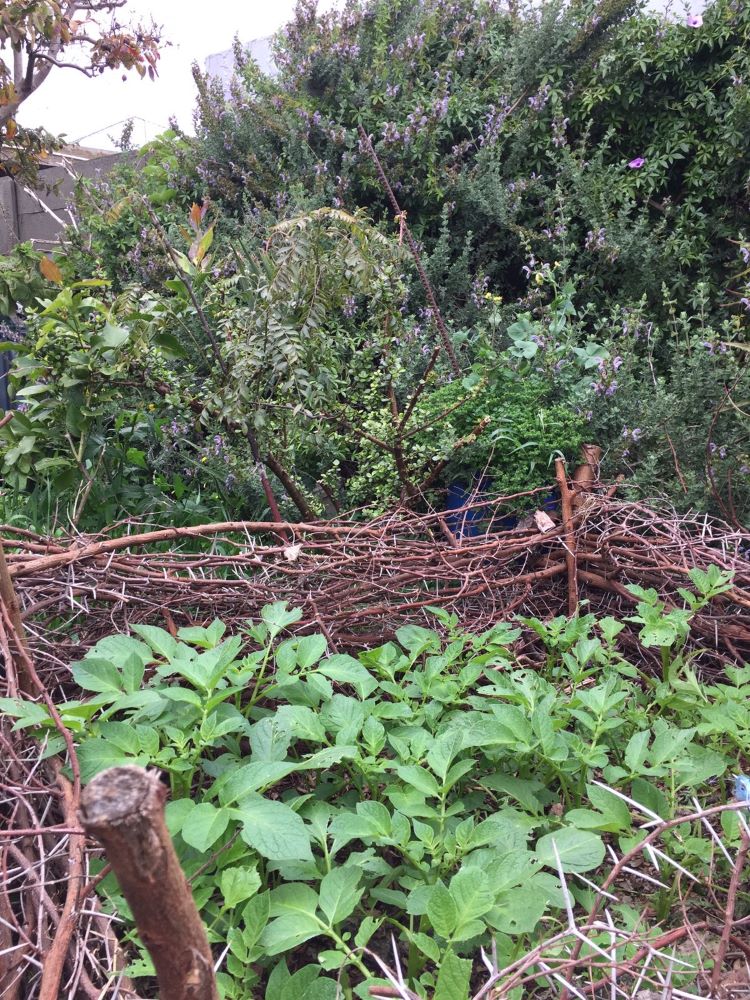 Potatoes, sweet thorn, blue salvia, lemon, curry, portulacaria create a tangle at eye level.
Potatoes, sweet thorn, blue salvia, lemon, curry, portulacaria create a tangle at eye level.Expanding on the meaning of jungle and what it cannot mean
Thus there is a sense of 'jangala' not being quite primeval forest, but natural, self restoring, a regeneration after human disturbance, coming into being when the hand of man is removed. The tangled appearance must refer to vines, and perhaps to a measure of invasiveness, as many plants in the early stages of succession in areas previously farmed can be invasive till the canopy shades them out. The jangala is thus filled with the layers missing in a European forest. The term's polysemy means it is applicable to wild desert vegetation where it is not irrigated, but also to tropical areas. It can refer to vegetation with large trees, but also to vegetation that tops out lower, with large shrubs. It can describe dry shrubland. As long as its multi storeyed and tangled it could even describe some overgrown fynbos !
If the jangal is part of a natural recovery process, then the gardener would maintain it by setting it back from time to time, opening up the canopy and preventing it from closing. It would be like succession continually interrupted. With more sunlight there are many more tiers of vegetation which can photosynthesize, enlivening the soil via root exudates. A stage in succession in which forest is relatively open, with light penetrating to the ground and lots of ground level vegetation achieving maximum photosynthesis would be extremely productive, as the effect of a forest at this stage would be to build up biomass and humus, and more fungi so that the soil can support larger and larger plants. The food jungle would not be in balance like a mature forest, but perpetually on the edge, about to close, or about to open up a little, being disturbed. Ernst Gotsch articulates this dynamic principle here.
I greatly prefer the idea of a food jungle to a food forest. Not everyone will agree, but for those who feel the same, I'm here to share my experience and lessons taken from multiple nature aligned forms of horticulture, including those with 100% biodiversity focus in which food is marginalized. I believe a balance between the two, an integration, would have great use, especially in urban areas with high human population and great nutritional needs. Like the difference between the meaning of jungle and forest, food-jungle clearly stands apart from the common understanding of the word food-forest. It cannot be applied to a collection of exotic fruit trees mulched with woodchips. It cannot just slip into that. The 'orchard' type of food forest is closer to the mental model of a forest from cold northern climes, which is well and good for those areas where it closely fits the pattern of nature, but I'm from the south, and do not want to cheat myself by building anything less than a jungle.
In the context of permaculture, many-tiered forests and biodiversity are spoken of but often this diversity of habitat within the forest sometimes becomes invisible in practice. A food jungle is of necessity wild and full of spiraling climbers, curves, webs, thorns, multiplicity of leaf and growth patterns, complexity and richness, rather than the two dimensionality of the forest idea, with its vertical trunks and flat floor. A food jungle may be less easy to harvest and seem less human friendly in the very short term, but it will extend biodiversity forward in time. An apple tree with big luscious sweet apples will not bite you, but the painful to touch Carissa macrocarpa will probably add more years to your life.
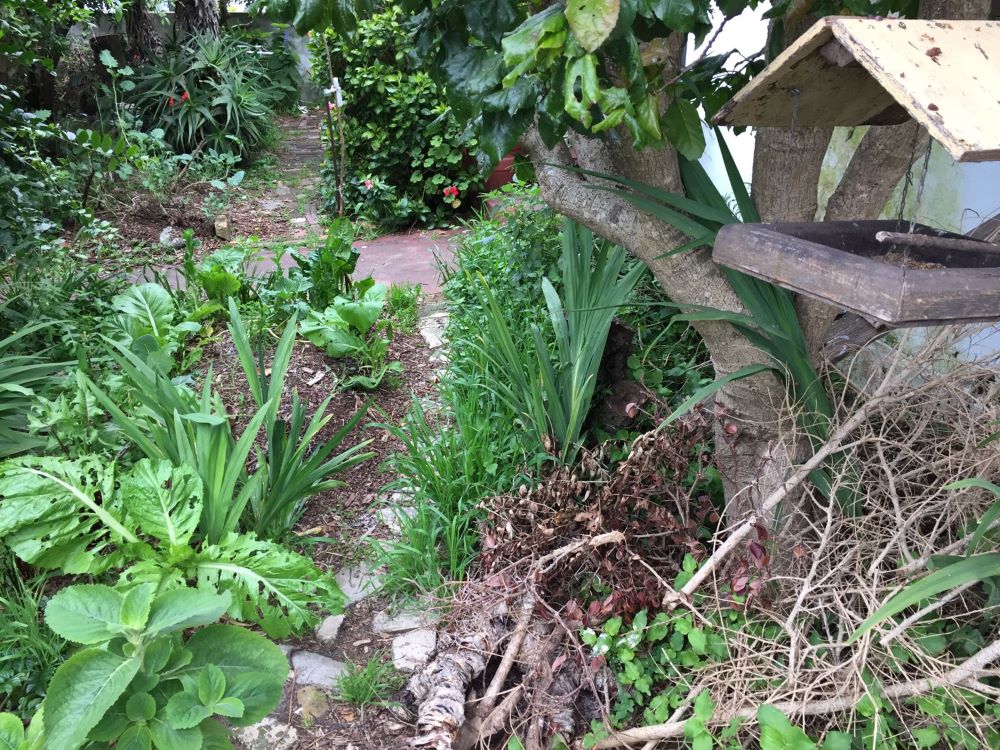 potatoes, sweet thorn branches, aloes and blue salvia
potatoes, sweet thorn branches, aloes and blue salviaSo what about the practicality of a food jungle system ?
There are ways and means of getting around the impenetrability of a jungle food system to harvest it. Judicious pruning, alleys and other patterns of open walkways and zoning are just some of the ways of making it workable. The methods advocated in the course will not be aimed at the agricultural business but at urban gardens with a high level of gardener involvement and no mass production.
One advantage of a food jungle is that it will survive. It can be planted on empty land in urban spaces and completely neglected while still providing highly nutritious food. Like vitamin supplements, the wild food supplements could help enormously with urban malnutrition based on over processed low nutrient diets, a global problem in urban areas, but without the cost of the pharmaceuticals.
Where to from here ?
In the articles that follow I will establish foundations and delve deeper into how to grow food in a semi wild jungle like biodiversity focused system.
Restore Nature Newsletter
I've been writing for four years now and I would love to hear from you
Please let me know if you have any questions, comments or stories to share on gardening, permaculture, regenerative agriculture, food forests, natural gardening, do nothing gardening, observations about pests and diseases, foraging, dealing with and using weeds constructively, composting and going offgrid.
Your second block of text...
SEARCH
Order the Kindle E-book for the SPECIAL PRICE of only
Prices valid till 30.09.2023
Recent Articles
-
garden for life is a blog about saving the earth one garden at a time
Apr 18, 25 01:18 PM
The garden for life blog has short articles on gardening for biodiversity with native plants and regenerating soil for climate amelioration and nutritious food -
Cape Flats Sand Fynbos, Cape Town's most endangered native vegetation!
Apr 18, 25 10:36 AM
Cape Flats Sand Fynbos, a vegetation type found in the super diverse Cape Fynbos region is threatened by Cape Town's urban development and invasive alien plants -
Geography Research Task
Jan 31, 25 11:37 PM
To whom it may concern My name is Tanyaradzwa Madziwa and I am a matric student at Springfield Convent School. As part of our geography syllabus for this
"How to start a profitable worm business on a shoestring budget
Order a printed copy from "Amazon" at the SPECIAL PRICE of only
or a digital version from the "Kindle" store at the SPECIAL PRICE of only
Prices valid till 30.09.2023







